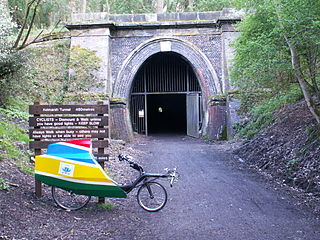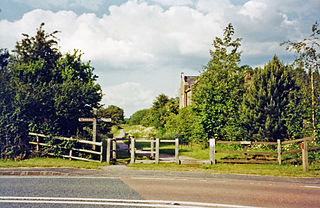
Northamptonshire is a ceremonial county in the East Midlands of England. It is bordered by Leicestershire, Rutland and Lincolnshire to the north, Cambridgeshire to the east, Bedfordshire, Buckinghamshire, Oxfordshire to the south and Warwickshire to the west. Northampton is the largest settlement and the county town.

Brixworth is a village and civil parish in West Northamptonshire, England. The 2001 census recorded a parish population of 5,162, increasing to 5,228 at the 2011 census. The village's All Saints' Church is of Anglo-Saxon origin.

The Kelmarsh Tunnels are disused railway tunnels in Northamptonshire, England. The Northampton to Market Harborough line opened in 1859 and had tunnels at Kelmarsh and nearby Oxendon.

The Oxendon Tunnels are disused railway tunnels in Northamptonshire, England. The Northampton to Market Harborough line opened in 1859 and had tunnels at Oxendon and nearby at Kelmarsh.

The Brampton Valley Way is a 14-mile (23 km) rail trail built on the way of the former Northampton to Market Harborough Railway in Northamptonshire, England. It forms what trail managers, Northamptonshire County Council, describe as a linear park.

The Northampton and Lamport Railway is a standard gauge heritage railway in Northamptonshire, England. It is based at Pitsford and Brampton station, near the villages of Pitsford and Chapel Brampton, roughly 5 miles (8.0 km) north of Northampton.

Market Harborough railway station is a Grade II listed station which serves the town of Market Harborough in Leicestershire, England. It is situated to the east of the town centre and lies on the Midland Main Line, 16 miles (26 km) south-east of Leicester.

The A508 is a 50.961 kilometres (31.666 mi), A-class road for north–south journeys in central and south central England, forming the route from Market Harborough in Leicestershire, via Northampton, to Old Stratford in Northamptonshire, just outside Milton Keynes.

Pitsford and Brampton railway station is a railway station serving the villages of Pitsford and Chapel Brampton in Northamptonshire, England.
The Great Northern and London and North Western Joint Railway was a British railway line, almost entirely within Leicestershire. Authorised by the same Act of Parliament, the Great Northern Railway Leicester Branch was built, branching from the Joint Line; on the same basis the Newark to Bottesford Line was built. The lines opened progressively between 1879 and 1883. The dominant traffic was iron ore, and the agricultural produce of the area served also generated considerable business. The passenger usage was never heavy, although some unusual through services were attempted at first.
Spratton railway station is a former railway station which served the village of Spratton in Northamptonshire, England.
The Northampton and Peterborough Railway was an early railway promoted by the London and Birmingham Railway (L&BR) to run from a junction at Blisworth on the L&BR main line to Northampton and Peterborough, in England. The construction of the line was authorised by Parliament in 1843 and the 47 mile line opened in 1845. The line largely followed the river Nene, and for the economy of construction, it had many level crossings with intersecting roads, rather than bridges. In 1846 the L&BR joined with other companies, together forming the London and North Western Railway (LNWR).
The Rugby and Stamford Railway was an early railway in England built in 1850. The London and Birmingham Railway had already built a branch from Blisworth to serve Northampton and extend to Peterborough. The success of this, the Northampton and Peterborough Railway encouraged the directors to look for other ventures. They decided upon a branch from Rugby to Stamford which would link up with other new railways in the east of the country.
The Bedford–Hitchin line was a branch of the Midland Railway which served stations at Cardington, Southill, Shefford and Henlow Camp in Bedfordshire, England. It opened in 1857, but was largely made redundant as a through-route to London by the extension of the Midland Main Line to St Pancras. The last passenger train ran in December 1961, yet goods services lingered on until 1964.

Church Brampton was a railway station on the Northampton Loop Line serving the village of Church Brampton in Northamptonshire.

Brixworth railway station on the Northampton and Market Harborough railway opened on 16 February 1859 serving the village of Brixworth, Northamptonshire, England. It ran half a mile west of the village towards the village of Creaton along what remains as Station Road. It was part of the London and North Western Railway. Apart from the passenger service the line also enabled a large ironstone field near the village to be developed which had been an important consideration in developing the line.

Lamport railway station on the Northampton and Market Harborough railway opened on 16 February 1859 serving the villages of Lamport, Maidwell, Hanging Houghton as well as Lamport Hall, Northamptonshire, England. It ran half a mile west of the village towards Maidwell just north of the road which was crossed by a level crossing. It was part of the London and North Western Railway. The next station north, Kelmarsh is located just north of Kelmarsh Tunnel.

Kelmarsh railway station on the Northampton and Market Harborough railway opened on 16 February 1859 serving the villages of Kelmarsh and Arthingworth, Northamptonshire, England. It ran almost equidistant between the two villages which are just under 2 miles (3.2 km) apart north-east of Kelmarsh and south-west of Arthingworth. It was part of the London and North Western Railway. The next station north, Clipston and Oxendon serving the villages of Great Oxendon and Clipston was situated south of Oxendon tunnel. To the south, Lamport was accessed via Kelmarsh tunnel.

Clipston and Oxendon railway station on the Northampton and Market Harborough railway opened in 1863 as a result of villagers' requests serving the villages of Clipston and Great Oxendon, Northamptonshire, England. It was about 1 mile south-east of the Oxendon and about 3 miles walking distance north-east of Clipston. It was south of Oxendon tunnel. It was part of the London and North Western Railway.

















